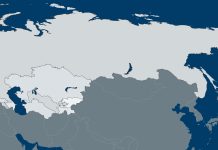By Jacob L. Shapiro
In October 2011, then-U.S. Secretary of State Hillary Clinton penned an article for Foreign Policy magazine about America’s “pivot” to Asia. Since then, it has become commonplace to speak about the United States attempting to rebalance its resources away from the Middle East and Europe towards the Asia-Pacific region, and to refer to this specifically as “the pivot to Asia.” But Europe and the Middle East have not diminished in importance for the United States – if anything their importance has only increased. The U.S. is a global power. Its perspective is therefore global; it cannot pivot between interests.
The main objective of U.S. grand strategy is to prevent the rise of a challenger to American power, and when the “pivot” is brought up, it is usually done in the context of the United States seeking to block China from assuming the mantle of the world’s next global power. We view this as a misunderstanding of geopolitics. China has neither the desire nor the capability to project that kind of power, and to develop such abilities would take decades. Chinese strategy is focused on strengthening its ability to resist a potential American attack or blockade – its development of ships, missiles, rockets and mines all point toward this goal.
This is not to say that the U.S. is unconcerned with the Asia-Pacific region. This is one of the problems with thinking in terms of pivots – it suggests that the U.S. wasn’t already invested. Since its victory in the Spanish-American War in 1898, the U.S. has been deeply involved in Asia – fighting the Germans in the Pacific in WWI, the Japanese in WWII and separate wars in Korea and Vietnam. Today, the U.S. maintains alliances with many Asian countries, such as Japan, South Korea and Australia, in order to ensure that a balance of power, with the United States as the ultimate security guarantor, remains in place. Just two weeks ago on March 1, a U.S. aircraft carrier group arrived in the Philippine Sea to hold exercises with India and Japan – in case China needed a reminder of U.S. naval superiority. But none of America’s moves in Asia mean that the U.S. can withdraw from Europe or the Middle East.
In terms of economic growth, East Asia may well be the world’s most dynamic region. But the combined GDP of the countries that make up the European Union is larger than any country’s GDP. According to 2014 International Monetary Fund figures, the EU’s GDP was over $18 trillion. That’s more than the United States – and it’s more than China, Japan and India combined. More important, however, is that the European Peninsula is the most strategically important area over which to hold influence in order to prevent the rise of a Eurasian hegemon. Europe emerged from World War II demoralized and critically wounded, but Europe is still the likeliest place for a potential challenger to U.S. hegemony to arise.
Europe also has become the epicenter for two political crises that threaten its cohesion: the problem of Russia and the obsolescence of the European Union. To the east, Russia continues to cast a large shadow. Today’s Russia is not a global power like the Soviet Union was, it is a significant regional power. But it is also a significant regional power in a position of extreme weakness. Russia’s economy is in shambles due to the collapse in oil, and no help seems to be on the horizon. Its demographic picture is extremely bleak – the Working Group on Families and Children of the Open Government projects that by 2050, Russia’s population will have declined by more than 20 percent. And Moscow miscalculated badly in Ukraine in 2014, leaving Russia weak in one of its most important buffer regions.
But weak powers are the most dangerous, because the desperation of their position makes them more aggressive than they otherwise would be. The U.S. is aware of both the dangers a weak Russia poses and how unprepared Europe is for Russian aggression. As a result, the U.S. is beefing up its military presence in Europe once more and developing bilateral relationships with key countries like Poland and Romania. The U.S. earmarked $789 million in fiscal year 2016 for the European Reassurance Initiative (ERI), which was established in June 2014 in response to Russia’s annexation of Crimea. On Feb. 2, the White House announced the ERI allocation for fiscal year 2017 – $3.4 billion, quadruple the previous amount. And according to the Military Times, the Pentagon is planning to move one or more Army brigade combat teams – thousands of troops – to Europe. These additions would be on top of plans already outlined in the ERI. This is to say nothing of the Caucasus and Central Asia, both historically Russia-dominated buffer regions that Moscow will struggle to control as it will have to rely less on money and more on brute force. Therefore, the U.S. must be involved in these regions as well.
The European Union is also in crisis, and that crisis is becoming enmeshed with the problem of Russia. It is not a crisis the U.S. can ignore anymore either. The cracks within the European Union are already manifesting in NATO, and the EU’s inability to develop a coherent policy on Syrian refugees has implications for terrorist capabilities across the world. But the real issue is that, at its core, the European Union was a way to solder the fates of Germany and France together, and its weakening means conflicts in Europe that have been inert for decades could reappear.
The European Union is the dream that disparate nation-states could come together and share a common political structure without also sharing a common language, common fears and common economic structures. Eastern Europeans fear a weak but assertive Russia – and the U.S. backs them up. But Germany’s security concerns are different, since it is somewhat farther removed from Russia and has U.S. support. Germany is much more concerned with preserving the EU because its economy depends on exporting German goods to eurozone countries. So Germany ends up in direct conflict with Greece, Italy and France over EU economic policies.
The re-emergence of European nationalism is not just an ideological phenomenon. It is the reassertion of national sovereignty by many individual states, each with their own competing interests. The result is a continent where Russia is frail but defiant, Eastern Europe is insecure and independent, southern Europe is facing more than 20 percent unemployment and economic hardship, and at the core, Germany and France are going in opposite directions. The world’s economic center of gravity may be in the process of shifting to Asia, but today, what happens in Europe still affects the entire world. The U.S. cannot leave Europe to stew in its own juices – it must be involved in its evolution.
Between Europe and Asia lies the Middle East. Five years ago, Clinton began her famous article by writing, “As the war in Iraq winds down and America begins to withdraw its forces from Afghanistan…” The notion of a pivot was based on the idea that the U.S. was going to invest more of its time and energy outside of the Middle East. But for all of Obama’s campaign promises, American troops will remain in Afghanistan after he leaves office, and the U.S. is once again active in both Iraq and now venturing into Syria as it attempts to build a coalition to fight the Islamic State. The U.S. now looks at IS and sees the potential for a regional, indigenous Arab power. It is a potentially strong enemy that could attack U.S. interests in the world and also upend the balance of power the U.S. is trying to reconstruct after the failure of the second Iraq War. Russia saw the U.S. predicament – needing to combat IS without wanting to commit troops – and recognized an opportunity to demonstrate its strength and perhaps give it some leverage with the Americans back in Eastern Europe.
Historically, the U.S. has been concerned with the Middle East because of the vast amount of oil there. But the U.S. now produces more oil than it imports and is on the way to becoming a net exporter of oil, so the importance of Persian Gulf oil to the U.S. has more to do with global stability than its own demand. But it has never been just oil that has concerned the United States in the Middle East. Besides the jockeying between Russia and the U.S. now, the countries involved in or talking about military action in the Middle East is a who’s who of the world’s second-tier powers – France, the U.K., Italy, Turkey. For over a century, the Middle East has been a playground for the world’s powers, and the U.S. cannot simply bow out there any more than it can allow China to have its way in the South China Sea.
Obama had many foreign policy goals when he became president. But as happened for the presidents before him and as will happen for the presidents that follow, no matter who they are or what party they are from, “policy” is not the way the world works. Policy is a way of imagining how one wants the world to work. We, however, are in the business of studying geopolitics – the way the world actually works. And for the U.S., that does mean pivoting to Asia, as long as pivoting to Asia includes simultaneously pivoting to Europe and to the Middle East. The U.S. must be involved and yet cannot be too involved in all of these regions. U.S. strategic demands are not conducive to tunnel vision.









